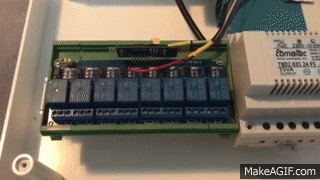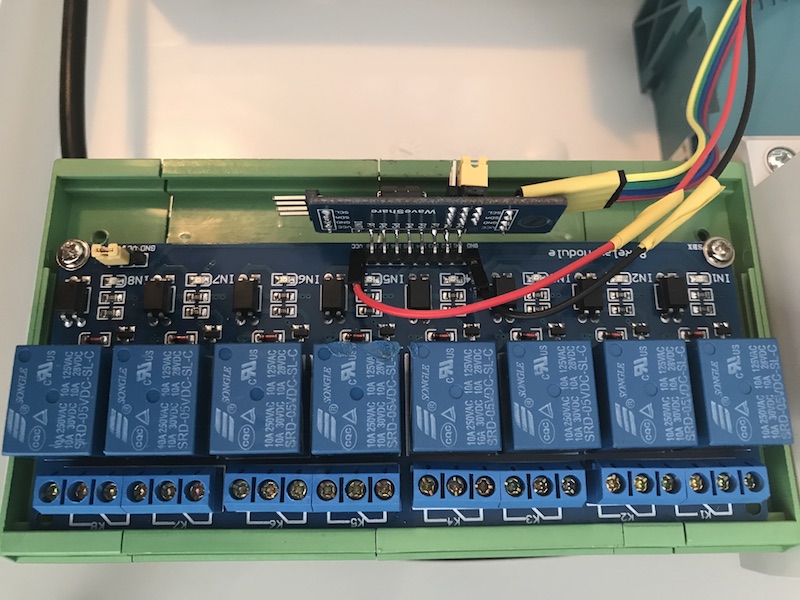I2CRelay: A Python library and command line tool to control PCF8574 I2C relay boards
I2CRelay is a small Python library that provides a simple API for controlling multiple relay boards that are connected to a PCF8574 I2C I/O expander.
This library was tested with the following hardware:
You can solder these into a single unit like this:
Requirements
- Ensure to enable i2c on the Rasberry Pi - see
sudo raspi-config, thenInterfacing Optionsand finally chooseI2C, selectEnable. - Reboot.
- Ensure to install Python 3 - On recent Rpi systems python 3.7.3 is already available from the system packages.
- Update apt repo info:
sudo apt-get update - Install system packages:
sudo apt-get install -y i2c-tools python3-pip
Installation
To install the latest version of the library from GitHub:
git clone -b master --single-branch https://github.com/oweidner/i2crelay.git
cd i2crelay
pip3 install --upgrade .Command-Line Tool
Together with the Python module installs the i2crelay command line tool:
Usage: i2crelay [OPTIONS] [CMDS]...
Control a PCF8574 I2C relay board.
Options:
--i2c-bus INTEGER The I2C bus (0 or 1) [required]
--i2c-addr TEXT The I2C device address, e.g. 0x20 [required]
--help Show this message and exit.For example, run this command to switch on relay 1 and 2, switch off relay 3 and toggle relay 8:
i2crelay --i2c-bus=1 --i2c-addr=0x20 1:on 3:off 2:on 8:toggleAPI Example
import time
from i2crelay import I2CRelayBoard
# define I2C bus type
# 0: Raspberry Pi Model B Rev 1.0
# 1: Raspberry Pi Model B Rev 2.0, Model A, Model B+, Model A+,
# Raspberry Pi 2 Model B and Raspberry Pi 3 Model B, Pi Zero (W)
I2C_BUS = 1
# define I2C address of PCF8574 8-Bit I/O expander
# depends on the hardware pins A0 - A2
I2C_ADDR = 0x20
r1 = I2CRelayBoard(I2C_BUS, I2C_ADDR)
r1.switch_all_on()
time.sleep(1.0)
r1.switch_all_off()
time.sleep(1.0)
for relay in range(1, 9):
print("Switching relay {}".format(relay))
r1.switch_on(relay)
time.sleep(0.5)
r1.switch_off(relay)
time.sleep(0.5)The code above should result in something like this:

Other Examples
The examples directory contains a few additional examples:
- rest_api.py - A simple REST API example with Flask
- simple.py - Modification of the
API Example
I2C Device Setup
Bus and Device Numbers
On Linux you can use the i2cdetect tool to figure out bus and device numbers:
To find out the I2C bus number, run:
i2cdetect -l
i2c-1 i2c bcm2835 I2C adapter I2C adapterTo find out the I2C device number, run:
i2cdetect -y 1
0 1 2 3 4 5 6 7 8 9 a b c d e f
00: -- -- -- -- -- -- -- -- -- -- -- -- --
10: -- -- -- -- -- -- -- -- -- -- -- -- -- -- -- --
20: 20 -- -- -- -- -- -- -- -- -- -- -- -- -- -- --
30: -- -- -- -- -- -- -- -- -- -- -- -- -- -- -- --
40: -- -- -- -- -- -- -- -- -- -- -- -- -- -- -- --
50: -- -- -- -- -- -- -- -- -- -- -- -- -- -- -- --
60: -- -- -- -- -- -- -- -- -- -- -- -- -- -- -- --
70: -- -- -- -- -- -- -- --Device Permissions
The user running the scripts needs access to the i2c devices in the Linux device tree. Instead of running the scripts as root you can add your user to the i2c group.
In modern Rasberry Pi systems it is alredy done, thus below command is not needed.
Below is example command to create groups gpio, i2c, spi and addig user
pi to those groups. Reboot to make sure it is in effect.
sudo groupadd gpio &&
sudo groupadd i2c &&
sudo groupadd spi &&
sudo usermod -aG gpio,i2c,spi piLicense
This program is free software; you can redistribute it and/or modify it under the terms of the GNU General Public License as published by the Free Software Foundation; either version 2 of the License, or (at your option) any later version.
